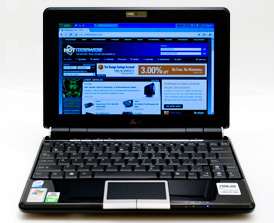Asus Eee PC 1000H Netbook
It has been almost exactly one year since we saw the Asus Eee line of notebooks hit store shelves and it has been quite a year for this little side project from Asus. The original Asus Eee PC lineup, even with its flaws, turned out to be a massive surprise hit, as Asus hit a price and form factor that the market was finally ready to adopt for an ultra-mobile notebook. The Eee PC, while not truly the first of its kind, cemented the "netbook' product category, which has encouraged potential buyers to accept this genre of products. Since its release, we've seen nearly every major OEM produce a similar product to compete with the Eee, although Asus's six month lead in this arena has helped them flesh out their product lineup even before their competitors got their first notebooks out.
In the last six months, Asus decided to explode their Eee lineup with a wide range of models, sizes, and feature sets. Depending on how you look at the situation, this can be seen as a positive or a negative growth for the Eee name. It's still the most commonly thought of brand name when considering an ultra-mobile PC, however, with so many models now out on the market, buyers have to read a grid, more or less, to find which model works for them. One trend is quite clear, even without reading model numbers, however, and that is "netbooks" are getting bigger. Not only in popularity, but in size and features, in order to accommodate the needs of a wider scope of potential consumers.
 | |
|
The Asus Eee PC 1000H Atom Netbook, Google Chrome loaded up on Hot Hardware. | |
First generation "netbooks" were equipped with 7-8 inch screens, which were sufficient given what people were demanding of the form factors of that time. However, if you want to do any actual work on one of these things, bigger (higher-resolution) screens and larger keyboards become necessary. Also, while cheap (and often-times, slow) solid state flash disks were used as storage and any type of real business or power-user would feel limited with only 8 or 16 GB of storage space. While not as sleek as a solid state hard drive, a standard 2.5" hard drive with a larger capacity would be needed. Business types won't buy brightly colored laptops, either, so the original Eee colors would have to be toned down, color-wise, in order to appeal to the worker-bee.
The result of all these demands for a business-class Eee PC model have led us to Asus 1000H, one of the latest members of the Eee family. In comparison to the original Eee, almost everything has changed, however, the core ultra-mobile Eee feeling remains more or less in-tact, even for those who require a larger screen. Has Asus hit a sweet spot with usability, size, and price, or have they just made the Eee PC into a big, bloated monster? Let's find out!






